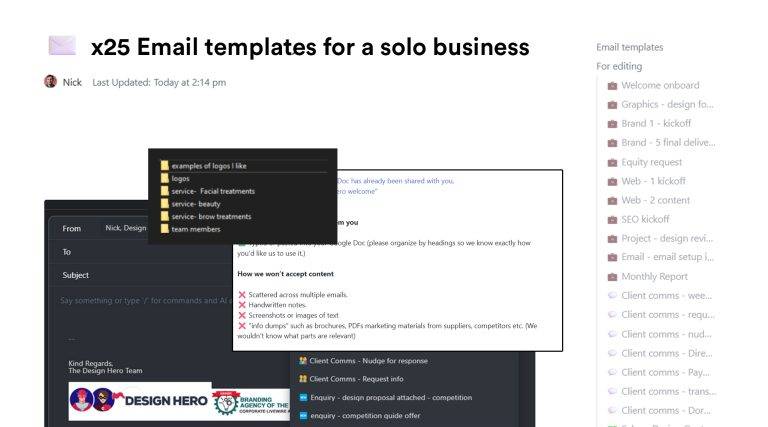A “good” client and a “bad” client can make the difference between a profitable project and a ballbusting burden.
It’s often not clear which is which until you’re knee deep in a project running overbudget and over timeline.
Most clients have a few red flags to watch out for.
Some have more than others…
Red flags don’t mean they are a bad client,
Red flags are just potential signposts to watch out for that could lead to problems later…
If you get caught unawares by clients,
it’s because you weren’t watching closely enough.
Here’s how to spot red flags, and how to deal with them appropriately.
Imagine you’re out a nice walk with the dog and you spot a squirrel
It’s much easier to spot the warning signs and call your dog to heel before he bolts,
than it is to hopelessly shout after them, trying to catch them as they disappear off into the bush.
Dogs will always give you a warning before they misbehave.
sometimes it will be an obvious snarl,
sometimes it will be a subtle sideways glance to check if you’re watching as they nibble on your slipper.
Sometimes they will be suspiciously quiet and you realise they have slunk away to scoff that cheesecake you left out in the kitchen.
People are no different.
Learn to spot those red flags and set your boundaries with clients before problems appear.
It’s all part of the game.
Here’s a list of the most common red flags to look out for
These will eat your profit margin and cause you stress:
- 🚩 Changes their mind a lot
- 🚩 unorganized
- 🚩 technophobic
- 🚩 Rude or abrupt comms
- 🚩 Expects immediate action
- 🚩 Payment issues
- 🚩 Price conscious
- 🚩 Slow responder (weeks)
- 🚩 Indecisive
- 🚩 Changes mind often
- 🚩 Unfocussed (adds features every time you speak to them)
- 🚩 Doesn’t like dogs (jokes)
Usually you can spot and adapt to these long before they become a problem.
Red flags aren’t the problem.
Unattended red flags are the problem.
There are no bad clients,
only badly managed clients.
Look for red flags during the sales call or introduction call
If they say any of these phrases:
- ”I’m not good with technology”
- “my last designer don’t get me”
- “I’m looking for something of really high quality, but I don’t have the most amount of money.”
- “I’m just looking for something basic. “
- “I’ll know what I want when I see it”
- “ I know exactly what I want, I just don’t know how to put it into words…or pictures….
- “I’m very particular”
- “I used to do design in 1980”
- “I used to work for X”
- “I could probably do it myself, I just don’t have time”
There are even specific words which are signs that the client is going to be trouble.
Keep an eye out for these minimizing words:
- Just
- Simple
- Basic
- Quick
- Favor
- Myself
- Picky
- Fussy
- Particular
All of those phrases are red flags that tell you this client is going to require more work or guidance than usual.
This doesn’t mean turn down the project or hang up the phone,
It’s just a signpost to us as a business owner, that this project is going to require more admin than usual.
How to adapt to client red flags as a freelancer
Even as early as the sales stage this is a chance to raise your minimum budget and level of investment.
Here’s how I change my behaviour and processes depending on the red flag behaviour.
- 🚩 Unorganized
- Price for strategy if needed
- Confirm everything in writing
- Make them compile their thoughts into one channel
- 🚩 Sporadic comms
- Set your policies in the onboarding email
- Change up your channels or how you communicate if necessary
- Don’t respond outwith those channels
- 🚩 Technophobic
- Be patient
- Increase budget to allow for extra handholding.
- Quote extra time for extra tech support and guidance
- 🚩 Rude or abrupt comms
- Make an allowance the first time, address it head on the second time with a gentle boundary.
- 🚩 Expects immediate action
- Explain to them how the “work queue” operates
- Always set out the turnaround time in writing for each task
- If necessary inform them next day turnaround isn’t realistic or reasonable.
- 🚩 Payment issues
- I allow the first time as a mistake, but after that inform the client about penalities, set late payment fees and stick to them.
- 🚩 Price-conscious
- explain your value
- don’t budge on budget
- don’t do discounts
- be on guard for scope creep and nibbling
- stick to the process more rigidly
- 🚩 Slow responder (weeks)
- set a weekly summary reminder,
- make them aware of timeline implications
- set a “dormant project policy” with a reactivation fee if it goes over 3 weeks
- 🚩 Indecisive
- Stick to your process more rigidly than usual
- Confirm everything in writing
- Explain how rounds of revisions work
- 🚩 Changes mind often
- Increase your quote to allow for more rounds of revisions
- Make them aware the cost impact of changing their mind.
- 🚩 Unfocussed (adds features every time you speak to them)
- Set a clearly defined scope of features to avoid feature creep
- 🚩 Doesn’t like dogs
- Run
If they have lots of red flags or are a bad fit you may even want to turn them down.
You don’t want to waste their time or yours by trying to please them.
If they don’t have the money or the budget to afford you,
You can politely say no.
But don’t just hang up on them.
Just say “Here’s some free resources that I can give you to do it yourself or I can refer you to a cheaper designer.”
😈 or if you’re feeling particularly evil today, refer them to your local competitor.
Of course there are exceptions to every rule.
It’s important not to overreact to red flags,
most clients will have at least one or two red flags which are manageable in isloation.
Some of my best clients have been technophobes 🤣
It just means they need a little bit more handholding than usual.
The most important thing
Are they polite and reasonable?
This is usually the best indication of a good relationship.
Note the red flags
If you spot or notice any red flags, add them to your Client Bible.
I keep a “client bible” for each of my clients, ever since Colby Wetger told me about his.
This is the go-to source on everything we know about our clients.
- What drives them?
- What did we promise them?
- What common ground do we have?
- What lights them up?
- What red flags do they have?

What if I’m already struggling with a red flag client?
If you’ve ignored, or missed, the red flags and taken on a tricky client,
here’s some stuff that will help:
📕 Q&As dealing with red flag clients as a freelancer
📕 LBD49 – How to turn an angry client into a loyal customer
📕 LBD46 – Why client favours are stinging you in the ass
Also…

Setting healthy boundaries as a freelancer doesn't have to be hard.
Subscribe for instant access to x50 foolproof email templates to set boundaries with clients.
















